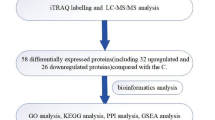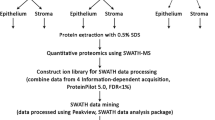Abstract
Purpose
To investigate the differentially expressed proteins (DEP) between high myopia and moderate myopia on the anterior corneal stroma.
Methods
Tandem mass tag (TMT) quantitative proteomics was utilized to reveal proteins. DEPs were screened by the multiple change of more than 1.2 times or less than 0.83 and the P value < 0.05. The DEPs were functional annotated by Gene Ontology (GO) terms. Proteins and protein interaction (PPI) networks were conducted with String online tool. Parallel reaction monitoring (PRM) data processing was used to verify the TMT proteomics results.
Results
There are 36 DEPs between high myopia and moderate myopia on the anterior corneal stroma, of which 11 proteins are upregulated, 25 proteins are downregulated. The GO analysis demonstrated keratinocyte migration and structural constituent of cytoskeleton that are significantly changed with most of the proteins decreased in high myopic corneas. Keratin 16 (KRT16) and erythrocyte membrane protein band 4.1-like protein 4B are the only two proteins involved in both functions. The PPI analysis showed keratin type II cytoskeletal 6A (KRT6A) and KRT16 that have strong connections. Immunoglobulin lambda variable 8–61(IGLV8-61) and nicotinamide phosphoribosyl transferase (NAMPT) have consistent results with the TMT.
Conclusions
The high myopic corneas have 36 DEPs compared to the moderate myopic corneas on the anterior corneal stroma. Keratinocyte migrations and structural constituent of cytoskeleton are weakened in high myopic corneas, which may partly account for the lower corneal biomechanics in high myopic eyes. The lower expressed KRT16 plays important roles in high myopic corneas.




Similar content being viewed by others
Abbreviations
- BP:
-
Biological processes
- CC:
-
Cellular components
- DEP:
-
Differentially expressed proteins
- GO:
-
Gene Ontology
- KEGG:
-
The Kyoto Encyclopedia of Genes and Genomes analysis
- KRT:
-
Keratin
- MF:
-
Molecular function
- PPI:
-
Protein-protein interactions
- PRM:
-
Parallel reaction monitoring
- SMILE:
-
Femtosecond laser small incision lenticule extraction
- TMT:
-
Tandem mass tag
References
Tedja MS, Haarman AEG, Meester-Smoor MA, Kaprio J, Mackey DA, Guggenheim JA, Hammond CJ, Verhoeven VJM, Klaver CCW (2019) Consortium C: IMI - myopia genetics report. Invest Ophthalmol Vis Sci 60(3):M89–M105
Cai XB, Shen SR, Chen DF, Zhang Q, Jin ZB (2019) An overview of myopia genetics. Exp Eye Res 188:107778
Wojciechowski R, Cheng CY (2018) Involvement of multiple molecular pathways in the genetics of ocular refraction and myopia. Retina 38(1):91–101
Dyrlund TF, Poulsen ET, Scavenius C, Nikolajsen CL, Thogersen IB, Vorum H, Enghild J (2012) Human cornea proteomeidentification and quantitation of the proteins of the three main layers including epithelium, stroma, and endothelium. J Proteome Res 11(8):4231–4239
Chen J, Wu W, Wang Z, Zhai C, Deng B, Alzogool M, Wang Y (2021) Novel corneal protein biomarker candidates reveal iron metabolic disturbance in high myopia eyes. Front Cell Dev Biol 9:689917
Wu W, Dou R, Wang Y (2019) Comparison of corneal biomechanics between low and high myopic eyes-a meta-analysis. Am J Ophthalmol 207:419–425
Kang BS, Wang LK, Zheng YP, Guggenheim JA, Stell WK, Kee C (2018) High myopia induced by form deprivation is associated with altered corneal biomechanical properties in chicks. PLoS One 13(11):e0207189
Chang L, Pan CW, Ohno-Matsui K, Lin X, Cheung GC, Gazzard G, Koh V, Hamzah H, Tai ES, Lim SC et al (2013) Myopia-related fundus changes in Singapore adults with high myopia. Am J Ophthalmol 155(6):991-999 e991
Harper AR, Summers JA (2015) The dynamic sclera: extracellular matrix remodeling in normal ocular growth and myopia development. Exp Eye Res 133:100–111
Han F, Li M, Wei P, Ma J, Jhanji V, Wang Y (2020) Effect of biomechanical properties on myopia: a study of new corneal biomechanical parameters. BMC Ophthalmol 20(1):459
Sedaghat MR, Momeni-Moghaddam H, Azimi A, Fakhimi Z, Ziaei M, Danesh Z, Roberts CJ, Monfared N, Jamali (2020) Corneal biomechanical properties in varying severities of myopia. Front Bioeng Biotechnol 8:595330
Ni Y, Wang L, Liu C, Li Z, Yang J, Zeng J (2022) Gene expression profile analyses to identify potential biomarkers for myopia. Eye (Lond) 37(6):1264–1270
Wu W, Wang Y, Zhang H, Zhang J, Li H, Dou (2016) One-year visual outcome of small incision lenticule extraction (SMILE) surgery in high myopic eyes: retrospective cohort study. BMJ Open 6(9):e010993
Kanehisa M, Furumichi M, Sato Y, Kawashima M, Ishiguro-Watanabe M (2022) KEGG for taxonomy-based analysis of pathways and genomes. Nucleic Acids Res 51(D1):D587–D592
He Q, Fang X, Zhu T, Han S, Zhu H, Li S (2019) Differential proteomics based on TMT and PRM reveal the resistance response of Bambusa pervariabilis x Dendrocalamopisis grandis induced by AP-toxin. Metabolites 9(8):166
Shi T, Song E, Nie S, Rodland KD, Liu T, Qian WJ, Smith RD (2016) Advances in targeted proteomics and applications to biomedical research. Proteomics 16(15–16):2160–2182
Gallien S, Kim SY, Domon B (2015) Large-scale targeted proteomics using internal standard triggered-parallel reaction monitoring (IS-PRM). Mol Cell Proteomics 14(6):1630–1644
Trost A, Desch P, Wally V, Haim M, Maier RH, Reitsamer HA, Hintner H, Bauer JW, Onder K (2010) Aberrant heterodimerization of keratin 16 with keratin 6A in HaCaT keratinocytes results in diminished cellular migration. Mech Ageing Dev 131(5):346–353
Chan JKL, Yuen D, Too PH, Sun Y, Willard B, Man D, Tam C (2018) Keratin 6a reorganization for ubiquitin-proteasomal processing is a direct antimicrobial response. J Cell Biol 217(2):731–744
Radaev S, Sun P (2002) Recognition of immunoglobulins by Fcgamma receptors. Mol Immunol 38(14):1073–1083
McKay TB, Hutcheon AEK, Zieske JD (2020) Biology of corneal fibrosis: soluble mediators, integrins, and extracellular vesicles. Eye (Lond) 34(2):271–278
Semba RD, Enghild JJ, Venkatraman V, Dyrlund TF, Van Eyk JE (2013) The human eye proteome project: perspectives on an emerging proteome. Proteomics 13(16):2500–2511
Li Q, Zhu H, Fan M, Sun J, Reinach PS, Wang Y, Qu J, Zhou X, Zhao F (2022) Form-deprivation myopia downregulates calcium levels in retinal horizontal cells in mice. Exp Eye Res 218:109018
Halasa AH, McLaren DS (1964) The refractive state of malnourished children. Arch Ophthalmol 71:827–831
Pan M, Zhao F, Xie B, Wu H, Zhang S, Ye C, Guan Z, Kang L, Zhang Y, Zhou X et al (2021) Dietary omega-3 polyunsaturated fatty acids are protective for myopia. Proc Natl Acad Sci USA 118(43):e2104689118
Cao J, Routh AL, Kuyumcu-Martinez MN (2021) Nanopore sequencing reveals full-length tropomyosin 1 isoforms and their regulation by RNA-binding proteins during rat heart development. J Cell Mol Med 25(17):8352–8362
Lippmann T, Jonkisz A, Dobosz T, Petrasch-Parwez E, Epplen JT, Dekomien G (2007) Haplotype-defined linkage region for gPRA in Schapendoes dogs. Mol Vis 13:174–180
Nakajima Y, Moriyama M, Hattori M, Minato N, Nakanishi S (2009) Isolation of ON bipolar cell genes via hrGFP-coupled cell enrichment using the mGluR6 promoter. J Biochem 145(6):811–818
Acknowledgements
Thanks for Tianjin Eye Hospital for providing the study subjects.
Funding
This study was funded by the National Natural Science Foundation of China (Grant No. 81900828, Wenjing Wu) and the Beijing Municipal Commission of Science and Technology Capital Clinical Diagnosis and Treatment Technology Research and Transformation Application (Grant Number Z201100005520043, Fengju Zhang).
Author information
Authors and Affiliations
Contributions
Wenjing Wu: study design; data collection, analysis and interpretation, and writing and revising the manuscript. Yushan Xu: revising the manuscript. Fengju Zhang: funding collection, study design, data analysis, and revising the manuscript. All authors read and approved the final manuscript.
Corresponding author
Ethics declarations
Ethical approval
All procedures performed in studies involving human participants were in accordance with the ethical standards of the Institutional Review Board (IRB) of Tianjin Eye Hospital and with the 1964 Helsinki declaration and its later amendments or comparable ethical standards. Informed consent was obtained from all individual participants included in the study. This article does not contain any studies with animals performed by any of the authors.
Conflict of interest
The authors declare no competing interests.
Additional information
Publisher's note
Springer Nature remains neutral with regard to jurisdictional claims in published maps and institutional affiliations.
Supplementary Information
Below is the link to the electronic supplementary material.
Rights and permissions
Springer Nature or its licensor (e.g. a society or other partner) holds exclusive rights to this article under a publishing agreement with the author(s) or other rightsholder(s); author self-archiving of the accepted manuscript version of this article is solely governed by the terms of such publishing agreement and applicable law.
About this article
Cite this article
Wu, W., Xu, Y. & Zhang, F. Comparisons of the protein expressions between high myopia and moderate myopia on the anterior corneal stroma in human. Graefes Arch Clin Exp Ophthalmol 261, 3549–3558 (2023). https://doi.org/10.1007/s00417-023-06158-2
Received:
Revised:
Accepted:
Published:
Issue Date:
DOI: https://doi.org/10.1007/s00417-023-06158-2




